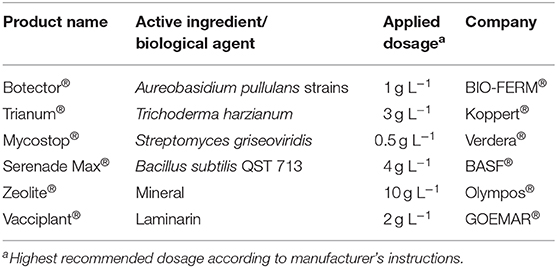
94% of researchers rate our articles as excellent or good
Learn more about the work of our research integrity team to safeguard the quality of each article we publish.
Find out more
CORRECTION article
Front. Microbiol., 04 February 2020
Sec. Food Microbiology
Volume 11 - 2020 | https://doi.org/10.3389/fmicb.2020.00029
This article is part of the Research TopicAspergillus-Derived Mycotoxins In The Feed And Food ChainView all 22 articles
This article is a correction to:
Effective Biopesticides and Biostimulants to Reduce Aflatoxins in Maize Fields
A Corrigendum on
Effective Biopesticides and Biostimulants to Reduce Aflatoxins in Maize Fields
by Lagogianni, C. S., and Tsitsigiannis, D. I. (2019). Front. Microbiol. 10:2645. doi: 10.3389/fmicb.2019.02645
In the original article, there was a mistake in Table 1 as published. The company that provided the product named “Botector” with the biological agent Aureobasidium pullulans strains is not “Syngenta” company but “BIO-FERM.” Also, the company that provided the product named “Vacciplant” with the active ingredient Laminarin is not “Arysta” company but “GOEMAR.”
The corrected Table 1 appears below.

Table 1. Commercial biopesticides and biostimulants used in the present study, active ingredients and applied doses according to manufacturer's instructions and company.
In the original article, there was an error. The wrong company name was used in the ACKNOWLEDGMENTS section.
A correction has to be made to ACKNOWLEDGMENTS paragraph:
“The authors are grateful to BIO-FERM, Koppert, BASF, and GOEMAR for providing the commercial formulations used in this study.”
The authors apologize for these errors and state that this does not change the scientific conclusions of the article in any way. The original article has been updated.
Keywords: Aspergillus ear rot, aflatoxins, Aspergillus flavus, biological control, mycotoxins
Citation: Lagogianni CS and Tsitsigiannis DI (2020) Corrigendum: Effective Biopesticides and Biostimulants to Reduce Aflatoxins in Maize Fields. Front. Microbiol. 11:29. doi: 10.3389/fmicb.2020.00029
Received: 05 January 2020; Accepted: 08 January 2020;
Published: 04 February 2020.
Approved by:
Frontiers Editorial Office, Frontiers Media SA, SwitzerlandCopyright © 2020 Lagogianni and Tsitsigiannis. This is an open-access article distributed under the terms of the Creative Commons Attribution License (CC BY). The use, distribution or reproduction in other forums is permitted, provided the original author(s) and the copyright owner(s) are credited and that the original publication in this journal is cited, in accordance with accepted academic practice. No use, distribution or reproduction is permitted which does not comply with these terms.
*Correspondence: Dimitrios I. Tsitsigiannis, dimtsi@aua.gr
Disclaimer: All claims expressed in this article are solely those of the authors and do not necessarily represent those of their affiliated organizations, or those of the publisher, the editors and the reviewers. Any product that may be evaluated in this article or claim that may be made by its manufacturer is not guaranteed or endorsed by the publisher.
Research integrity at Frontiers

Learn more about the work of our research integrity team to safeguard the quality of each article we publish.